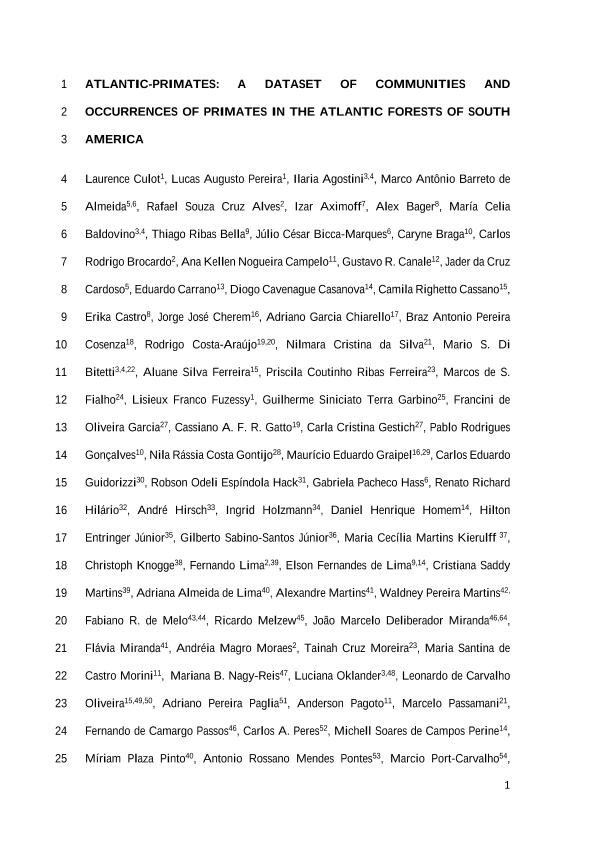Artículo
ATLANTIC ‐ PRIMATES : a dataset of communities and occurrences of primates in the Atlantic Forests of South America
Culot, Laurence; Pereira, Lucas Augusto; Agostini, Ilaria ; Almeida, Marco Antônio Barreto; Alves, Rafael Souza Cruz; Aximoff, Izar; Bager, Alex; Baldovino, María Celia
; Almeida, Marco Antônio Barreto; Alves, Rafael Souza Cruz; Aximoff, Izar; Bager, Alex; Baldovino, María Celia ; Bella, Thiago Ribas; Bicca Marques, Júlio César; Braga, Caryne; Brocardo, Carlos Rodrigo; Campelo, Ana Kellen Nogueira; Canale, Gustavo R.; Cardoso, Jader da Cruz; Carrano, Eduardo; Casanova, Diogo Cavenague; Cassano, Camila Righetto; Castro, Erika; Cherem, Jorge José; Chiarello, Adriano Garcia; Cosenza, Braz Antonio Pereira; Costa Araújo, Rodrigo; Silva, Nilmara Cristina da; Di Bitetti, Mario Santiago
; Bella, Thiago Ribas; Bicca Marques, Júlio César; Braga, Caryne; Brocardo, Carlos Rodrigo; Campelo, Ana Kellen Nogueira; Canale, Gustavo R.; Cardoso, Jader da Cruz; Carrano, Eduardo; Casanova, Diogo Cavenague; Cassano, Camila Righetto; Castro, Erika; Cherem, Jorge José; Chiarello, Adriano Garcia; Cosenza, Braz Antonio Pereira; Costa Araújo, Rodrigo; Silva, Nilmara Cristina da; Di Bitetti, Mario Santiago ; Ferreira, Aluane Silva; Ferreira, Priscila Coutinho Ribas; Fialho, Marcos de S.; Holzmann, Ingrid
; Ferreira, Aluane Silva; Ferreira, Priscila Coutinho Ribas; Fialho, Marcos de S.; Holzmann, Ingrid ; Oklander, Luciana Inés
; Oklander, Luciana Inés ; Pereyra, Lucas Augusto
; Pereyra, Lucas Augusto
 ; Almeida, Marco Antônio Barreto; Alves, Rafael Souza Cruz; Aximoff, Izar; Bager, Alex; Baldovino, María Celia
; Almeida, Marco Antônio Barreto; Alves, Rafael Souza Cruz; Aximoff, Izar; Bager, Alex; Baldovino, María Celia ; Bella, Thiago Ribas; Bicca Marques, Júlio César; Braga, Caryne; Brocardo, Carlos Rodrigo; Campelo, Ana Kellen Nogueira; Canale, Gustavo R.; Cardoso, Jader da Cruz; Carrano, Eduardo; Casanova, Diogo Cavenague; Cassano, Camila Righetto; Castro, Erika; Cherem, Jorge José; Chiarello, Adriano Garcia; Cosenza, Braz Antonio Pereira; Costa Araújo, Rodrigo; Silva, Nilmara Cristina da; Di Bitetti, Mario Santiago
; Bella, Thiago Ribas; Bicca Marques, Júlio César; Braga, Caryne; Brocardo, Carlos Rodrigo; Campelo, Ana Kellen Nogueira; Canale, Gustavo R.; Cardoso, Jader da Cruz; Carrano, Eduardo; Casanova, Diogo Cavenague; Cassano, Camila Righetto; Castro, Erika; Cherem, Jorge José; Chiarello, Adriano Garcia; Cosenza, Braz Antonio Pereira; Costa Araújo, Rodrigo; Silva, Nilmara Cristina da; Di Bitetti, Mario Santiago ; Ferreira, Aluane Silva; Ferreira, Priscila Coutinho Ribas; Fialho, Marcos de S.; Holzmann, Ingrid
; Ferreira, Aluane Silva; Ferreira, Priscila Coutinho Ribas; Fialho, Marcos de S.; Holzmann, Ingrid ; Oklander, Luciana Inés
; Oklander, Luciana Inés ; Pereyra, Lucas Augusto
; Pereyra, Lucas Augusto
Fecha de publicación:
11/2018
Editorial:
Ecological Society of America
Revista:
Ecology
ISSN:
0012-9658
Idioma:
Inglés
Tipo de recurso:
Artículo publicado
Clasificación temática:
Resumen
Primates play an important role in ecosystem functioning and offer critical insights into human evolution, biology, behavior, and emerging infectious diseases. There are 26 primate species in the Atlantic Forests of South America, 19 of them endemic. We compiled a dataset of 5,472 georeferenced locations of 26 native and 1 introduced primate species, as hybrids in the genera Callithrix and Alouatta. The dataset includes 700 primate communities, 8,121 single species occurrences and 714 estimates of primate population sizes, covering most natural forest types of the tropical and subtropical Atlantic Forest of Brazil, Paraguay and Argentina and some other biomes. On average, primate communities of the Atlantic Forest harbor 2 ± 1 species (range = 1–6). However, about 40% of primate communities contain only one species. Alouatta guariba (N = 2,188 records) and Sapajus nigritus (N = 1,127) were the species with the most records. Callicebus barbarabrownae (N = 35), Leontopithecus caissara (N = 38), and Sapajus libidinosus (N = 41) were the species with the least records. Recorded primate densities varied from 0.004 individuals/km2 (Alouatta guariba at Fragmento do Bugre, Paraná, Brazil) to 400 individuals/km2 (Alouatta caraya in Santiago, Rio Grande do Sul, Brazil). Our dataset reflects disparity between the numerous primate census conducted in the Atlantic Forest, in contrast to the scarcity of estimates of population sizes and densities. With these data, researchers can develop different macroecological and regional level studies, focusing on communities, populations, species co‐occurrence and distribution patterns. Moreover, the data can also be used to assess the consequences of fragmentation, defaunation, and disease outbreaks on different ecological processes, such as trophic cascades, species invasion or extinction, and community dynamics. There are no copyright restrictions. Please cite this Data Paper when the data are used in publications. We also request that researchers and teachers inform us of how they are using the data.
Archivos asociados
Licencia
Identificadores
Colecciones
Articulos(CCT - NORDESTE)
Articulos de CTRO.CIENTIFICO TECNOL.CONICET - NORDESTE
Articulos de CTRO.CIENTIFICO TECNOL.CONICET - NORDESTE
Articulos(IBIGEO)
Articulos de INST.DE BIO Y GEOCIENCIAS DEL NOA
Articulos de INST.DE BIO Y GEOCIENCIAS DEL NOA
Articulos(IBS)
Articulos de INSTITUTO DE BIOLOGIA SUBTROPICAL
Articulos de INSTITUTO DE BIOLOGIA SUBTROPICAL
Citación
Culot, Laurence; Pereira, Lucas Augusto; Agostini, Ilaria; Almeida, Marco Antônio Barreto; Alves, Rafael Souza Cruz; et al.; ATLANTIC ‐ PRIMATES : a dataset of communities and occurrences of primates in the Atlantic Forests of South America; Ecological Society of America; Ecology; 100; 1; 11-2018; e02525
Compartir
Altmétricas



